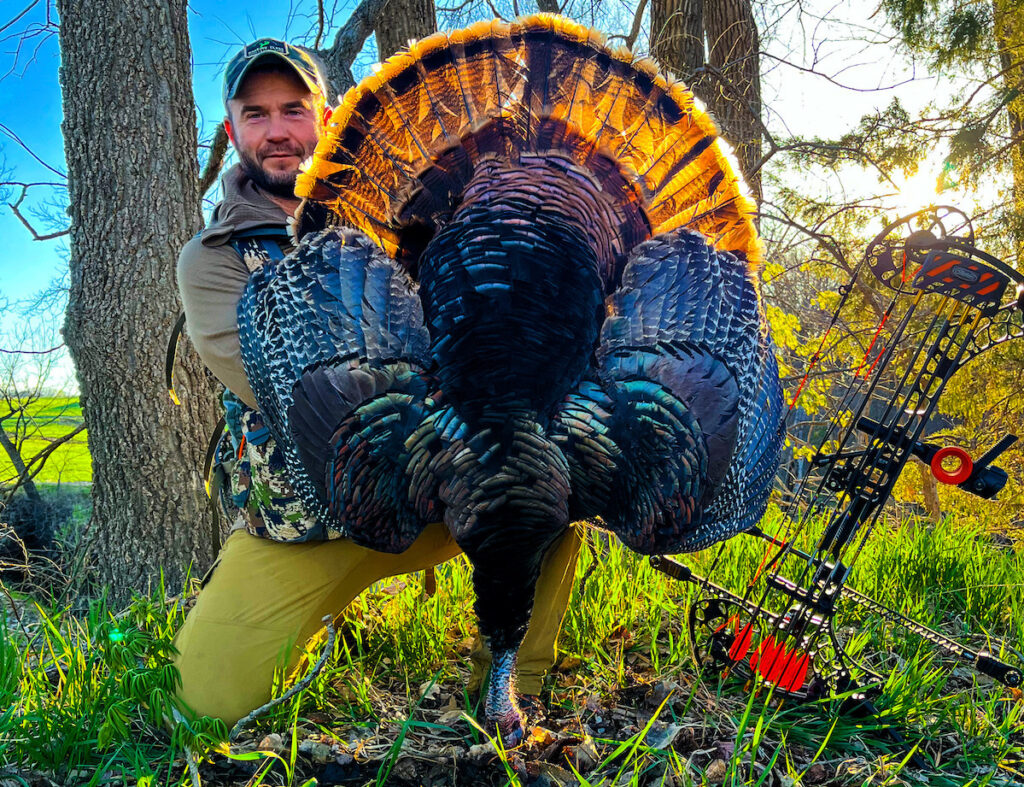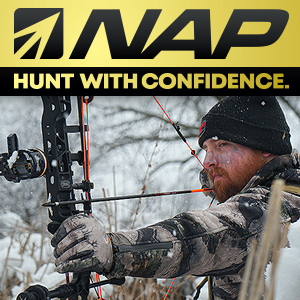Eastern turkeys are arguably the most difficult sub-species to tag with archery tackle. This is especially true if you’re planning a run-and-gun bowhunt. Still, shish-kabobing, a big old Eastern bird, is possible. You just need to have the right playbook.
by Clint Casper
There’s no doubt in my mind that in today’s world, when hunting public or private, being quick, light, and mobile in the turkey woods will lead you to more thrilling opportunities.
Regarding subspecies of turkeys and their habitats, Eastern birds are one of the most challenging species to bowhunt. This is especially true if you want to hunt them without a ground blind. This style has been my absolute favorite for the last ten years. Here are a few tips I’ve gathered over that tenure to help YOU succeed this spring while running and running for Eastern birds.
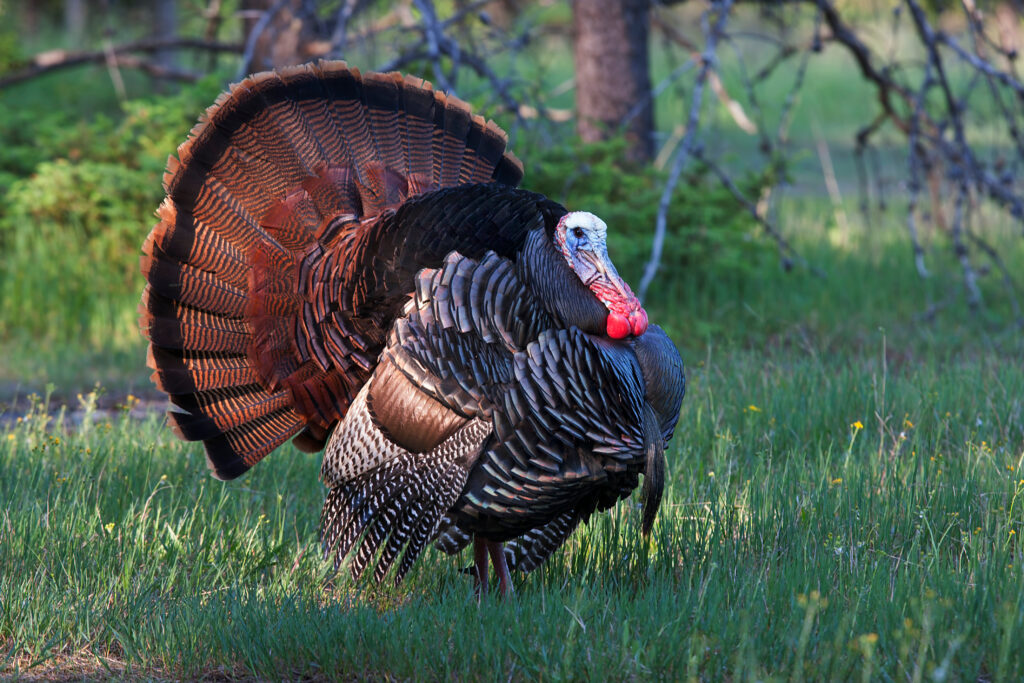
The Right Gear
Running and gunning is a different concept of turkey hunting than the traditional decoy and blind setup. I have always hunted turkeys aggressively and love to make moves and go to them more often than waiting for them to come to me.
Regarding gear, right out of the gate, we need to talk about clothing and boots. I prefer to be as lightweight as possible anytime I hunt, but bowhunting turkeys like this is extremely important. You need a quiet, breathable clothing system that will allow you to cover a magnitude of temperature changes. I prefer Sitka Gear. Their Equinox Turkey line is built for fast-paced turkey hunting, as it’s light, super quiet, breathable, and, when paired together as a system, extremely weatherproof and warm.
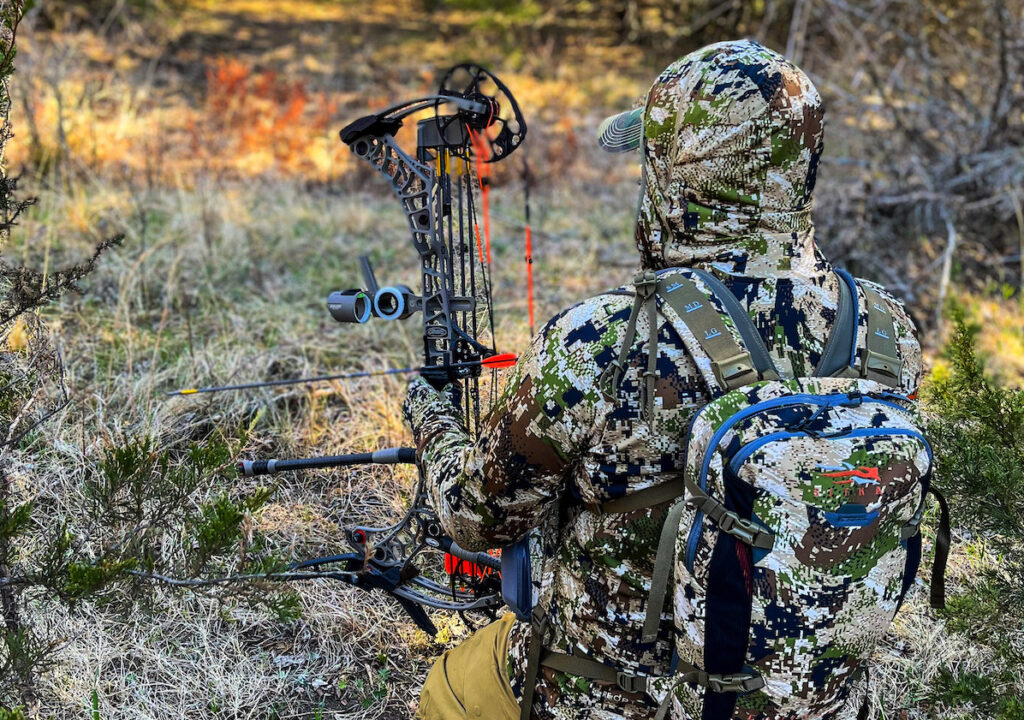
They also make a vest, which is streamlined and fully functional for the mobile turkey hunter. It has enough pockets to hold gear, water bottles, rain jackets, and more. It’s lightweight and very compact. Leave that oversized, bulky vest that you’ve had for ten years at home. This is a vest made for running and gunning!
Again, like with my clothing, I want a lightweight, breathable, and waterproof set of boots. Ounces equal pounds, and pounds equal pain during an all-day turkey hunt. Keep this in mind when purchasing boots. Some of my lightweight spring kicks include makes from HanWag, Scarpa, and Crispi. These brands check all of the boxes for me.
A Good Optics System
Binoculars, a bino harness, and a good rangefinder are invaluable when turkey hunting without a ground blind and decoys.
I’m using Maven optics for binoculars and running their B.6 10x50s. This is the perfect size for turkey and whitetail hunting anywhere in the country. I’m also using their RF.1 Rangefinder. This rangefinder has angle compensation, a 7×25 built-in optic lens, and Field/Forest mode, allowing a bowhunter to quickly scan and range no matter the terrain he is in.
I store my optic system — my knife, extra mouth calls, a phone charger, licenses, and a small set of wrenches — in my Kifaru Bino Harness. This harness completely covers and protects my optics, keeping my essential gear tight to my chest and readily available.
Calls & Decoys
For calls and decoys, I’m a very minimalist bowhunter. Typically, I’ll have a few mouth calls with different reeds and cuts for various sounds. A slate call and a glass call with two strikers, one box call, and a call conditioner. This system allows me to cover any and all types of turkey vocabulary in any weather conditions. Make sure you can use mouth calls effectively. Inclement weather creates a tough time for pot and box-style calls. It’s a great advantage to have a mouth call ready when at full draw, as you won’t be able to use a pot-and-peg or a box.
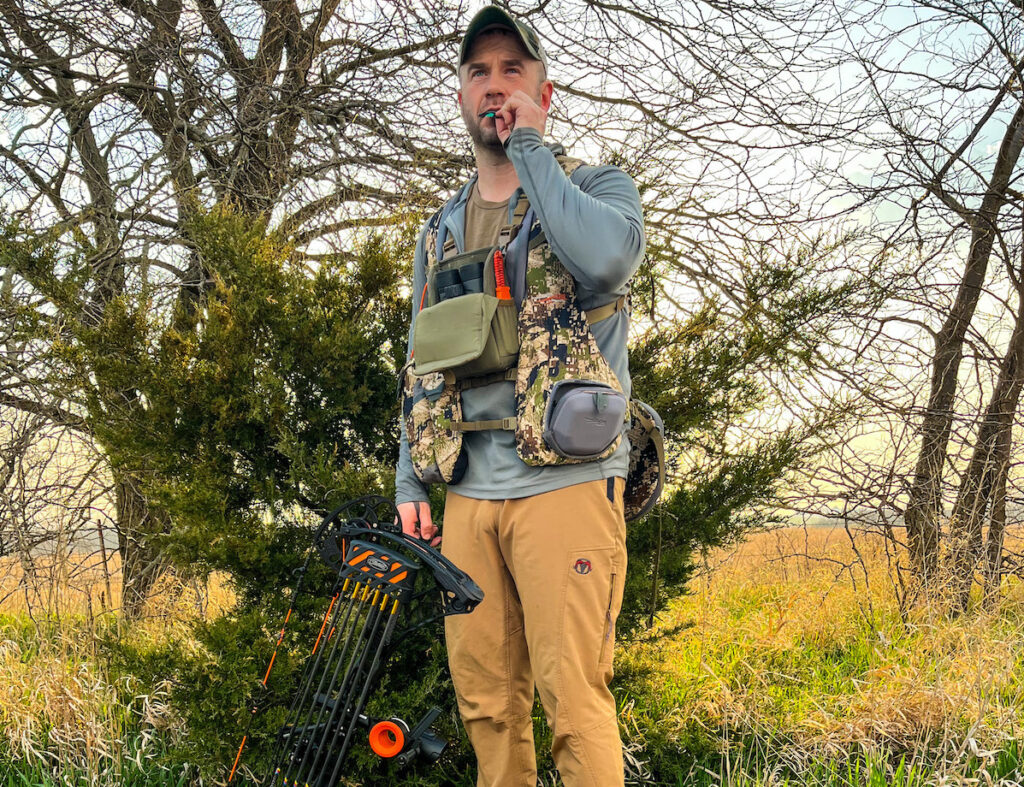
As far as decoys go, I like a foldable, lightweight design. I’m not into carrying a specific decoy bag and lugging around heavy decoys. I want lightweight and fast. I don’t always carry decoys, but with new and improved lightweight models like Higdon Outdoors’ new FLEX Tom and Hen, I usually find myself toting fakes these days. These decoys fold in half and weigh next to nothing.
Think Like A Turkey
Now that we’ve got the right gear, we must start thinking about getting within bow range of springtime birds. I break each hunt down into three parts: right off the roost, mid-morning, and late morning. Some states allow for all-day hunting, but I’m going to focus on the morning half of the hunt, which all states allow.
When it comes to being successful at running and gunning with your bow, it’s essential to never be steps behind the birds but steps ahead. I want to always be where the turkeys will be instead of trying to chase them from behind. This puts me in the driver’s seat instead of chasing from the rear. For this reason, my game plans are very strategic each day, but I’m also ready and able to be flexible and change at a moment’s notice.
I’m always trying to envision where the birds will roost and want to fly down. If I have knowledge of where they like to roost, I’m already in the game. But, if I do not, I will use tools like onX Hunt to locate good roosting spots. Eastern birds love to roost on oak-covered ridgetops and creek bottoms, especially those near agriculture fields. I’m looking for areas that provide good landing areas for the flocks once they fly down. Logging roads, oak flats, inside corners of field edges, and open creek bottoms are great spots. I want to be at these spots well before sunrise and ready for the birds to fly down. Typically, they’ll be henned up, so my calling will be minimal, as I don’t want the hen to take the flock away.
I’m hoping these turkeys land in my lap or close to it. If not, I’ll make my moves based on what I’m seeing and hearing, but carefully so I do not give away my presence.
Mid-morning birds are easier to find and work with. If I’ve been on birds since daybreak, I’ll stick close to them and try to figure out where they want to be as the morning progresses. Sometimes, you can call a tom off his hens, but more times than not, he will gobble at you but never close the distance. As the morning progresses, more and more hens get bred or go to lay on nests. This frees up the boys, as they’ve become bored with their hens from the morning. Now is a great time to try to fire one up with some calling and sneak in close!
I like to get a bird to gobble and then quickly move my location to him, sounding as natural as possible. Once I’ve got him gobbling good, I’ll typically go silent and make him close that final distance into bow range. This tactic allows me to pick the best ambush spot and then force him to come to me. Remember, we are bowhunting, so we need good shooting lanes and visibility.
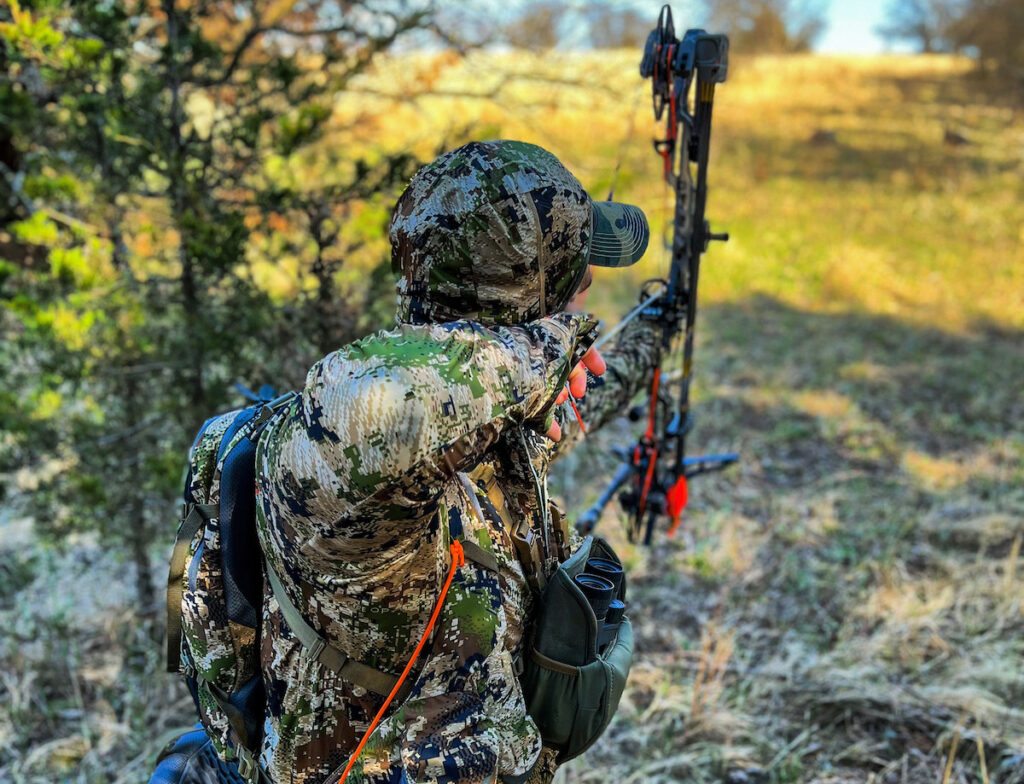
Beware, you’ll probably call in more than one bird at a time during this time frame, so keep an eye out before you draw!
Late-morning turkeys are my favorite to bowhunt. I have the most success during this time of the day. Most of the toms are single and ready to mingle.
I like to work the outside edges of the property first and then go in deeper. During this time, excited yelps, cuts, and locator class like an owl hoot or crow call are great ways to get a tom to crack.
Once you get a bird to give away his location, it’s time to get serious. I like to be aggressive during this time and mimic an excited and talkative hen. This typically gets a tom fired up and ready to play the game. n
With a tom answering, I move to a spot that will be easy for the longbeard to navigate. It’s now a waiting game. Typically, though, the fired-up tom will act fast and come looking. It’s essential to avoid deep creeks, fences, or any other obstacle between you and the bird’s path of travel. And try to have something in front of you to hide that will allow you to draw.
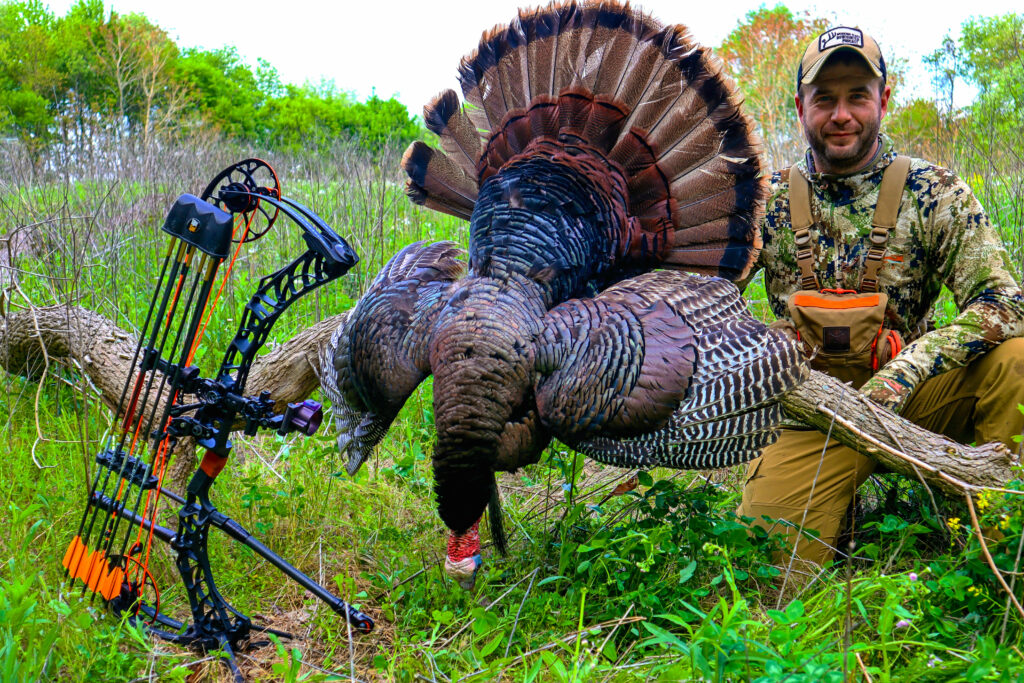
Failure is YOUR prerequisite to success, and that couldn’t be truer with this style of turkey hunting. You will fail far more than you will succeed when bowhunting turkeys this way, but the success is worth the hard work and tough lessons. Good luck, and may your arrow fly true!
